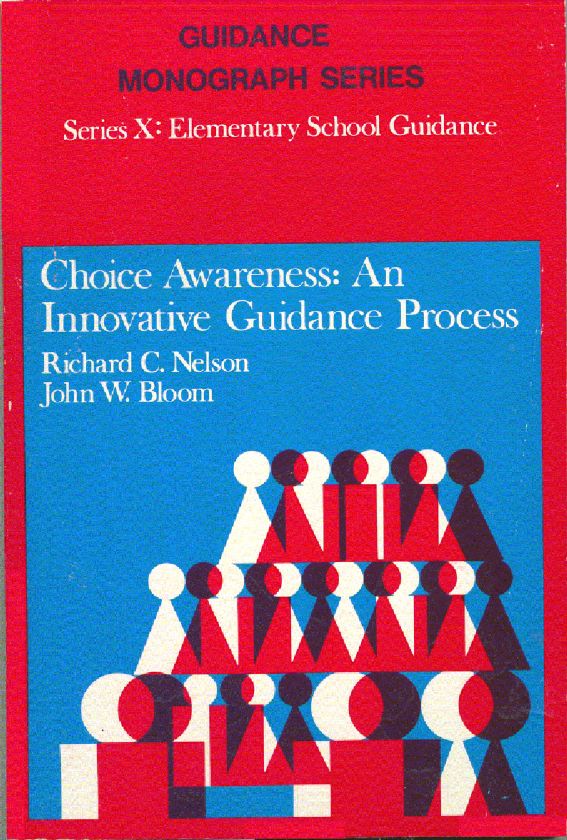|
CHOICE AWARENESS: |
|
|
CHOICE AWARENESS: An Innovative
Guidance Process appeared originally as part of a 10-book series of
elementary school guidance monographs designed for use by counselors,
teachers, and others who work with children in school settings. This source
introduces educational professionals to the concepts of Choice Awareness and
provides many specific suggestions for developing choice-making concepts and
skills with children. The first three chapters of CHOICE
AWARENESS introduce the concepts to educational professionals, and suggest
how they might apply the concepts in their own lives and in communication,
counseling, and teaching. Chapter 4, Presenting Choice Awareness to Students,
provides a plan for presenting each of 12 concepts in an active, involving
way. The first excerpt that follows is from the introduction to Chapter 4,
then portions from Concept 2: You Have Many Choices, are presented. |
|
Note that the cover picture is the original, the cover of the present edition is more generic. |
|
|
Chapter 4 |
Thus far, Choice Awareness has been developed through clarifying and
extending the choices of the teacher or counselor. Here we explore the
presentation of the concepts of Choice Awareness directly to students.
Organization
We conceptualize from one to three sessions of from 20- to 40-minutes being
invested in each of the twelve concepts that follow, depending on the age level
of the group and the thoroughness of the exploration.
Experience has shown that the activities are useful at any grade level
between two and eight, and, with minimal adaptation, even that range might be
extended. We see it being desirable to re-explore the ideas at different grade
levels if activities are varied and particularly if students enter into the
planning process.
One way in which the concepts may be explored is through the three-step
process that is described below.
Step One -- Input Session
During the input session, time is devoted to total group presentation,
experiencing, and discussion. The major objective should be the introduction of
the concept so that students get the feel of it and come to enjoy it as an
idea.
Step Two -- Activity Session
During the activity session, time is provided for buzz groups, dyadic
experiences, free writing exercises, sketching, and otherwise exploring the
concept.
Step Three -- Implementation Session
During the implementation session, focus is on utilization of the idea,
discussion of the ways in which the ideas have been tried at home or with
classmates, dramatization of the concept -- resulting from creative writing by
members of the group, exploration of snags encountered, and plans for further
exploration of the concept in everyday relationships.
There are four ways in which we can see these materials being used:
- with an entire classroom of children;
- with one half of the children in a class, then the other -- while the teacher or counselor engages in a different activity with the remaining group;
- with a small group of four to ten students; or
- in an abbreviated form with a single student.
(The omission at this point discusses Assumptions that are made, Materials
that may be needed, suggested Handout pages that may be copied or adapted to
fit the age level of the group, Alternative Procedures that may be used to tie
the concepts into curricular activities such as creative writing, and the Style
of Presentation viewed as appropriate.)
|
Concept 2: You Have Many Choices |
This concept demonstrates that each opportunity to make a choice can be met
in a variety of ways. Either-or, right-wrong terminology suggests that two
alternatives may exist; in reality often there are hundreds of choices that can
be made. Even when choices seem to be limited, there are choices to be made
involving both means and attitudes. This concept provides for experiences that
clarify the wide range of choices that can be made in each situation.
See parallel section in Chapter 1 (I Have Many Choices) for further
clarification regarding this concept.
Materials
1. Handout page adapted to grade level, vocabulary, and intended use.
[Actual page omitted in this sample.] Note that this material may be presented
as two or three separate pages for distribution. Something to Do Now may be
dealt with in greater detail.
2. Sufficient cards of the samples below for half the class.
|
You think: |
"I feel sorry for that person." |
What do you say/do? |
|
" |
"Just yesterday,
I warned that person about this kind of thing." |
" |
Procedures
- Review. Brief review of You Make Many Choices. [The previous section.] Report of experiences.
- Introduction of topic. You Have Many Choices.
- Choice variety. Through a number of experiences, the point to be made is that each situation may be met in a variety of ways.
-
- Ask each person to respond in a way not yet expressed to the statement: "Hi, how are you?" Deliver the comment directly to each individual. Reward variety and action as well as words.
- Ask each person to think: I have the urge to ask a friend over this afternoon. What are all the ways in which I might handle that urge? Expand samples given -- have them enacted. Include such ideas as feeling sure that person won't come, asking the parent, etc.
- As above: How many ways can students your age show or tell a person you like him/her?
- How many ways can you think of to go to work on a school assignment?
- How many ways could you find to respond to someone who makes an error in a game on the playground?
- Entering a room. With a room arranged [in a fishbowl circle with] a simulated teacher's desk and desks of two students -- each person who wishes is asked to show a new way to enter the room. The individual clarifies whether or not the teacher and the other student (or one of them) are present. Model for the group -- "Joe and the teacher are in their seats." Sauntering, waving at them: "HIYA, teach. HIYA, Joe!"
- Group members are to try to make different choices.
- Cards. Distribute cards (see Materials) to pairs of students or to triads. Each group has a member who says something like: "Oh, I just got into some terrible trouble because of two of my friends." A second member is to act the way the card tells him/her to act in response to the comment. If there is a third group member, that person may act as announcer, telling the class what the directions on the card said and indicating what part each is playing. Groups are given one or two minutes to plan a brief dialogue. Call on groups. Applaud efforts.
Handout
If the handout [omitted here] is introduced after the cards have been used,
the first portion can function as a brief summary. The second portion, Something
to Do Now, can be completed if time permits. Discuss To Try on Your Own.
Encourage group members to think about ways in which these suggestions might be
implemented.
Alternative Procedures
Further Role Plays: Develop similar experiences and prepare cards as above.
For example, first student expected to be chosen for a team, a chorus, a
special group, etc., but wasn't.
Unfinished Stories: Build an initial paragraph describing the finding of a
purse or wallet, a problem of being picked on for being too small, etc., and
have the group write the continuation and ending for the story.
Dear Abby Bulletin: Ask students to prepare brief letters to DEAR ABBY.
Place one at a time on a bulletin. Invite responses to be cleared through a
committee and placed on the bulletin. Change materials frequently -- perhaps
twice weekly.
Response to Music. Listen to a piece of classical music twice. Have groups
of four plan how they will respond to the piece in a third playing. Encourage
uniqueness as all groups perform simultaneously.
Summary Questions
Do you really see that each situation can be met in many ways? Can you think
of some situations which don't have as many choices as we have shown? (Frankl
in Man's Search for Meaning suggests
that even when we must do something, we can at least choose the attitude with
which we will do it -- and he wrote that from a concentration camp.) Of what
value is it to know that each situation can be met in many ways?
Can you think of some choices you often make that you would like to change
in the future?
This book is out of print. A
limited number of copies may be obtained from the author via: stoptc@frontier.com
Top
| Stop Think Choose Homepage | Seminars
This page created and maintained by Dick Nelson; last updated February
3, 2011

